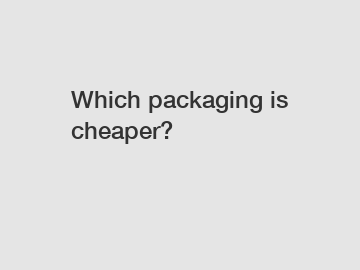Which packaging is cheaper?
Which Packaging is Cheaper?
Packaging plays a crucial role in protecting and preserving products during transportation and storage. It also serves as an essential marketing tool, attracting potential customers and influencing their purchasing decisions. However, businesses often face the challenge of determining which type of packaging is more cost-effective. In this article, we will explore different types of packaging and compare their costs, helping you make an informed decision for your business.
Primary Packaging: The First Layer of Protection.

Primary packaging refers to the immediate container or wrapping that directly houses the product. It is typically the first layer of protection and comes in various forms such as bottles, jars, tubes, or boxes. When evaluating the cost of primary packaging, several factors need to be considered, including the material, size, and design complexity.
1. Material: The material used for primary packaging significantly impacts its cost. Plastics, glass, and metals offer different cost ranges based on their availability, production processes, and market demand. For instance, plastic packaging is often cheaper compared to glass or metal due to its lower production costs and lightweight nature.
2. Size: The size of the primary packaging also affects its cost. Smaller packaging requires less material, resulting in reduced costs. Additionally, smaller packaging can lead to savings in transportation and storage expenses due to its compact nature.
Secondary Packaging: Enhanced Protection and Branding Opportunities.
Secondary packaging is the outer layer that provides additional protection to the primary packaging. It includes materials like cardboard boxes, shrink wrap, or blister packs. In addition to protection, secondary packaging also offers branding opportunities, allowing companies to showcase their logos, slogans, and other marketing information.
1. Cardboard Boxes: Cardboard boxes are widely used for secondary packaging due to their affordability and versatility. They can be easily customized to fit different products and come in various shapes and sizes. Moreover, cardboard boxes can be recycled, making them environmentally friendly and cost-effective in the long run.
2. Shrink Wrap: Shrink wrap is a popular choice for bundling multiple products together. It offers a tight and secure wrap around the primary packaging, protecting it from dust, moisture, and tampering. Shrink wrap is cost-effective compared to other secondary packaging options, primarily due to its low material cost and efficient application process.
Tertiary Packaging: Ensuring Safe Transportation.
Tertiary packaging refers to the outermost layer that provides additional protection during transportation and storage. Its primary purpose is to keep products safe from damage, theft, and harsh environmental conditions. Common examples of tertiary packaging include pallets, stretch wrap, and strapping.
1. Pallets: Pallets are a standard choice for transporting goods in bulk. They are typically made of wood, plastic, or metal and provide stability and support during transportation. While the initial cost of pallets can be higher, they can be reused multiple times, making them a cost-effective option in the long term.
2. Stretch Wrap: Stretch wrap, also known as cling film, is used to secure products onto pallets or bundling them together. It offers protection against dust, moisture, and tampering. Stretch wrap is relatively affordable and easy to apply, making it a cost-effective option for tertiary packaging.
Conclusion.
In conclusion, determining the cheaper packaging depends on various factors such as material, size, and specific requirements. Plastic packaging, cardboard boxes, and stretch wrap are generally considered cost-effective options due to their affordability, versatility, and efficient application process. However, it is crucial to assess your unique product needs and consult packaging experts to make a well-informed decision.
If you have any further questions or need assistance in choosing the right packaging for your business, please feel free to contact us.
Want more information on dips and sauce packaging manufacturers, iml container manufacturers, Discount Food Packaging in Bulk? Feel free to contact us.


